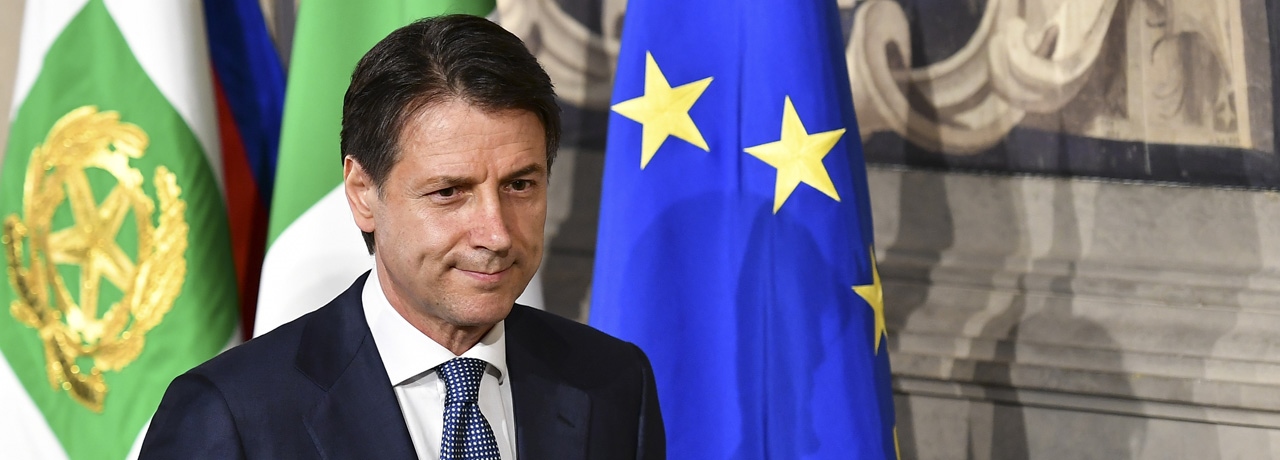Italy’s new Prime Minister
June 6, 2018 | Expert Insights

Giuseppe Conte, Italy’s new Prime Minister, has made his first speech. Conte, who was sworn in on June 1st, took a strong anti-immigration stance, calling for a reform of EU asylum regulation. Conte’s government was formed by a coalition between the populist anti-establishment Five Star Movement (M5S) and the far-right League parties.
Conte also called for a review of sanctions on Russia.
Background
Present day Italy is known as a vibrant tourist destination in Europe. It is the 3rd-largest national economy in the Eurozone, the 8th-largest by nominal GDP in the world. Italy is also the eighth largest exporter in the world. In 2016, its nominal GDP was $1.850 trillion. Italy conducted 59% of its trade with other nations in the European Union.
Politically, Italy has often been plagued by instability in the 20th and the 21st century. After the First World War, the nation was economically weakened. In 1922, the National Fascist Party of Benito Mussolini came to power. This resulted in protectionism and greater control by the government. There have been several dozen governments in the country since the advent of the Second World War. The Italian political landscape underwent a seismic shift in the early 1990s when the "mani pulite" ("clean hands") operation exposed corruption at the highest levels of politics and big business. Despite hopes of a change, the old power structures remained largely unchanged. Under the leadership of Silvio Berlusconi, politics was mired by controversies and scandals.
The 2018 general elections were called by President Sergio Mattarella in December 2017, after he dissolved the Parliament. They were held in March. The campaigning saw a marked shift towards the far right and was built upon the anti-immigration wave. It also saw the return of former leader Silvio Berlusconi as a dominant force in national politics. The centre-right alliance, in which Matteo Salvini's League emerged as the main political force, won a plurality of seats in the Chamber of Deputies and in the Senate. However, no political group or party won an outright majority, resulting in a hung parliament.
Italy’s incoming Prime Minister Giuseppe Conte was sworn in on June 1st after the President Sergio Mattarella agreed to a revised cabinet. Conte, a law professor who has never held political office, is backed by the anti-establishment Five Star Movement (M5S) and the far-right League party. The two populist and Eurosceptic parties, who were rivals in the March elections, came together to form a coalition and avoid snap elections. Head of the League Matteo Salvini and M5S leader Luigi di Maio are now Conte’s deputy Prime Ministers. A vote in the chamber of deputies on 6th May will confirm the new cabinet.
Analysis
In his first speech as Prime Minister, Conte reiterated a number of promises from his election manifesto. Curbing immigration has been a major part of Conte’s politics. “We will end the immigration business, which has grown out of all proportion under the cloak of fake solidarity,” he said in a recent speech. Referring to EU rules that asylum seekers must submit applications in the country of arrival, he said, “We will strongly call for the Dublin regulation to be overhauled in order to obtain respect for a fair distribution of responsibilities and to achieve an automatic system of compulsory distribution of asylum seekers."
Over 600,000 immigrants have come to Italy since 2014, according to UN figures. The immigration section of the new coalition’s policy document calls the deportation of Italy’s undocumented immigrants a “priority.” Conte has also called for building more detention centres.
Conte denied that Italy would leave the Eurozone. "Leaving the euro was never up for discussion," the new Prime Minister said. "The issue is another: Is it legitimate or not for a government of a country to re-negotiate economic policy?" Italy is the Eurozone’s third-largest economy. Recent political turmoil, as well as promises of high spending have shaken investor confidence.
Conte said, “We want to reduce the public debt, but we want to do it by increasing our wealth, not with austerity that, in recent years, has helped to make it (public debt) grow.” He added, "Italian public debt is fully sustainable today. However, its reduction must be pursued, but with a view to economic growth." Moody’s Investors Service said in a statement that the coalition’s economic proposals would lead to “a weaker, not a stronger, fiscal position,” pointing to “potentially costly tax and spending measures, without any clear proposals on how to fund those.”
Observers have noted that the political events in Italy are part of a growing far-right movement in Europe. Far-right groups such as Germany's AfD and France's National have performed better than expected in general elections. Analysts have attributed this to a rise in anti-immigration sentiment across Europe. Austrian Chancellor Sebastian Kurz, who will assume the EU's presidency in July, has also been described by some as Eurosceptic and far-right.
Assessment
Our assessment is that the formation of the Conte government has brought temporary reprieve to the political crisis. However, as noted previously, the President of the nation is pro-European Union and the government has positioned itself anti-Europe and anti-immigration. Political uncertainty is therefore likely to continue. We believe that the new government could pose a threat to Italy’s future in the Eurozone. This would be a cause for concern among investors and liberal European governments alike.








Comments